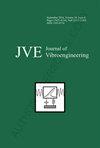Lightweight steering equipment based on prestressed modal analysis
IF 0.9
Q4 ENGINEERING, MECHANICAL
引用次数: 0
Abstract
As the key component to control the driving direction of the vehicle, the steering device always bears large vibration and load. In order to improve structural performance and reduce costs, a multi-objective optimization method based on the results of prestressed modal analysis was proposed, which can achieve significant lightweight and cost-effectiveness improvement. Based on the principle and working characteristics of the steering device, the minimum value of mass, minimum value of maximum stress, maximum value of equivalent stiffness were set as optimization objectives. Through finite element analysis, the prestressed modal module was constructed, and the strength and modal characteristics of the steering device were obtained. In order to verify the accuracy of prestressed modal analysis, the vibration testing experimental platform was built in a non free state. The excitation and response signals can be obtained through sensors and data acquisition devices and used as input and output data. According to the comparative analysis of simulated vibration modes, it can be concluded that the coupling analysis of strength and mode is more in line with actual boundary conditions and has high reliability. The DOE (Design of Experience) method was adopted to construct discrete corresponding values between design variables and optimization objectives based on the results of prestressed modal analysis. In order to better evaluate the cost-effectiveness of lightweight, a comparative analysis was conducted on the results of primary and secondary lightweight. The results show that the prestressed modal analysis method can achieve good dynamic analysis accuracy. Without reducing strength and equivalent stiffness, the mass of the steering device can be reduced by 14 %, achieving high economic benefits.基于预应力模态分析的轻型转向设备
作为控制汽车行驶方向的关键部件,转向装置始终承受着巨大的振动和载荷。为了提高结构性能、降低成本,提出了一种基于预应力模态分析结果的多目标优化方法,可实现显著的轻量化和性价比提升。根据转向装置的原理和工作特性,将质量最小值、最大应力最小值、等效刚度最大值设定为优化目标。通过有限元分析,构建了预应力模态模块,得到了转向装置的强度和模态特性。为了验证预应力模态分析的准确性,建立了非自由状态下的振动测试实验平台。通过传感器和数据采集设备获得激励信号和响应信号,并将其作为输入和输出数据。根据模拟振动模式的对比分析,可以得出结论:强度与模式的耦合分析更符合实际边界条件,可靠性高。根据预应力模态分析结果,采用 DOE(经验设计)方法构建设计变量与优化目标之间的离散对应值。为了更好地评估轻量化的成本效益,对一次轻量化和二次轻量化的结果进行了对比分析。结果表明,预应力模态分析方法可以实现良好的动态分析精度。在不降低强度和等效刚度的情况下,转向装置的质量可减少 14%,实现了较高的经济效益。
本文章由计算机程序翻译,如有差异,请以英文原文为准。
求助全文
约1分钟内获得全文
求助全文
来源期刊

Journal of Vibroengineering
工程技术-工程:机械
CiteScore
1.70
自引率
0.00%
发文量
97
审稿时长
4.5 months
期刊介绍:
Journal of VIBROENGINEERING (JVE) ISSN 1392-8716 is a prestigious peer reviewed International Journal specializing in theoretical and practical aspects of Vibration Engineering. It is indexed in ESCI and other major databases. Published every 1.5 months (8 times yearly), the journal attracts attention from the International Engineering Community.
 求助内容:
求助内容: 应助结果提醒方式:
应助结果提醒方式:


